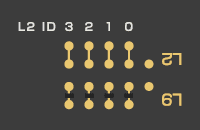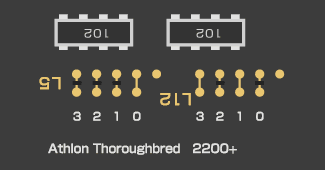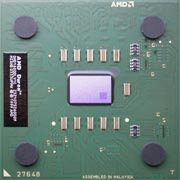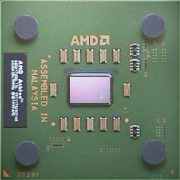Athlon XP, Bridge configurations
The following reports are applicable in Barton and Thoroughbred including Thorton and Applebred.
The corresponding product is Athlon XP, Sempron, and Duron.
However, the content of this page is not necessarily certain. Please confirm it by yourself.
These contents require the knowledge of Electronic parts.
Function of the bridge for the desktop CPUs.
Bridge number
- L1 : It is connected from L3 to BP_FID pin.
- L2,L9 : Level2 Cache controls
- L3 : Start up Multipliers
- L5 : Operation mode of CPU
- L6 : SFID, Rated Multiplier for Mobile
- L8 : SVID, Maximum Core voltage for Mobile
- L11 : VID, Start up Core voltage
- L12 : FSB auto-detection
- Summary : About closing of the bridges
L1 : It is connected from L3 to BP_FID pin.

L1 bridge(Electronic point of contact) has connected between L3 and BP_FID Pin. Therefore, in order to change the Multiplier from the Motherboard, it is required for the whole of L1 to have closed.
L2 : Level2 Cache controls
 Although L2 bridge controls Level2 Cache size, the state where all are closed is a default.
Although L2 bridge controls Level2 Cache size, the state where all are closed is a default.
All L9 is opened. However, this bridge is not related to recognition of L2.
However, this bridge is required when controlling L2-Cache from the outside of CPU.
| OPN | L2[3:0] | L2 Cache | Products |
| AXDA1700DLT3C | CCCC | 256k T-bred CORE | Athlon XP |
| AXMH2200FQQ3C | Athlon XP-M | ||
| SDA2400DUT3D | Sempron | ||
| ANXS1750FXC3S | Geode NX | ||
| AXDA2500DKV4D | CCCC | 512k Barton CORE | Athlon XP |
| AXMG2600FQQ4C | Athlon XP-M | ||
| SDA3000DUT4D | Sempron |
T-bred* = Thoroughbred
Thorton [ AMD athlon Processor Model 10 w/256K L2 Cache ]
The Thorton is using the Barton core. We think that this bridge setup is a decisive difference with Barton.
| OPN | L2[3:0] | L2 Cache | Development code |
| AXDC2400DKV3C AQXEA 0337TPMW 9738095270198 | CCC: | 256k | Thorton |
| AXDC2000DUT3C AQXCA 0321MPMW 9871266270062 | CC:C | 256k | Thorton |
Applebred [ AMD Duron Processor Model 8 w/64K L2 Cache ]
The new Duron called Applebred is using the Thoroughbred core. Though it is the same core as Athlon, it is Duron because L2 [3] is open. Just this bridge setup considers us to be the decisive differences from Thoroughbred.
| OPN | L2[3:0] | L2 Cache | Development code |
| DHD1600DLV1C MIXHB 0333VPMW Z321435240056 | :CC: | 64k | Applebred |
| DHD1600DLV1C MIXHB 0333UPMW Z321075260221 | :CCC | 64k | Applebred |
: = Open (Level:H)
C = Closed (Level:L)
Though all these bridges are closed, L2 Cache does not necessarily operate correctly.
We recommend you to perform the Torture-test of Prime95
I think that L3[1] and L3[0] will become selection of the invalid area of L2 Cache.
This bridge seems to be the same function as Palomino. Please refer to the following page.
Palomino/L2 details
L3 : SYSCLK Multiplier
Caution : In the super-locked Athlon XP and Sempron, the multiplier doesn't change even if you change these bridges.
It is the important bridge which sets up the Multiplier of Athlon XP.

- Close L3-FID 4 : 5X to 12.5X
- Open L3-FID 4 : Over13X
On this page, Multiplier bridges are written to be L3-FID bridges.
Barton FSB:167
| Multiplier | Clock (FSB167) | L3-FID[4:0] | Model# |
| 5.0x | 833 | CC:CC | - |
| 5.5x | 917 | CC:C: | - |
| 6.0x | 1000 | CC::C | - |
| 6.5x | 1083 | CC::: | - |
| 7.0x | 1167 | C:CCC | - |
| 7.5x | 1250 | C:CC: | - |
| 8.0x | 1333 | C:C:C | - |
| 8.5x | 1417 | C:C:: | - |
| 9.0x | 1500 | C::CC | - |
| 9.5x | 1583 | C::C: | - |
| 10.0x | 1667 | C:::C | - |
| 10.5x | 1750 2100 | C:::: | - *3000+ |
| 11.0x | 1833 2200 | CCCCC | 2500+ *3200+ |
| 11.5x | 1917 | CCCC: | 2600+ |
| 12.0x | 2000 | CCC:C | - |
| 12.5x | 2083 | CCC:: | 2800+ |
| Multiplier | Clock (FSB167) | L3-FID[4:0] | Model# |
| 13.0x | 2167 | :C:CC | 3000+ |
| 13.5x | 2250 | :C:C: | - |
| 14.0x | 2333 | :C::C | - |
| 21.0x | - | :C::: | - |
| 15.0x | 2500 | ::CCC | - |
| 22.0x | - | ::CC: | - |
| 16.0x | 2667 | ::C:C | - |
| 16.5x | 2750 | ::C:: | - |
| 17.0x | 2833 | :::CC | - |
| 18.0x | 3000 | :::C: | - |
| 23.0x | - | ::::C | - |
| 24.0x | - - | ::::: | - |
| n/a | Invalid | :CCCC | - - |
| 19.0x | - | :CCC: | - |
| n/a | Invalid | :CC:C | - |
| 20.0x | - | :CC:: | - |
C = Closed , : = Open , * = FSB:200
Thoroughbred FSB:133
| Multiplier | Clock (FSB133) | L3[4:0] | Model# |
| 5.0x | 667M | CC:CC | M_100* |
| 5.5x | 733M | CC:C: | - |
| 6.0x | 800M | CC::C | M_133* |
| 6.5x | 867M | CC::: | - |
| 7.0x | 933M | C:CCC | - |
| 7.5x | 1.00G | C:CC: | - |
| 8.0x | 1.07G | C:C:C | - |
| 8.5x | 1.13G | C:C:: | - |
| 9.0x | 1.20G | C::CC | - |
| 9.5x | 1.27G | C::C: | - |
| 10.0x | 1.33G | C:::C | - |
| 10.5x | 1.40G | C:::: | - |
| 11.0x | 1.47G | CCCCC | 1700+ |
| 11.5x | 1.53G | CCCC: | 1800+ |
| 12.0x | 1.60G | CCC:C | 1900+ |
| 12.5x | 1.67G | CCC:: | 2000+ |
| Multiplier | Clock (FSB133) | L3[4:0] | Model# |
| 13.0x | 1.73G | :C:CC | 2100+ |
| 13.5x | 1.80G | :C:C: | 2200+ |
| 14.0x | 1.87G | :C::C | - |
| 21.0x | - | :C::: | - |
| 15.0x | 2.00G | ::CCC | 2400+ |
| 22.0x | - | ::CC: | - |
| 16.0x | 2.13G | ::C:C | 2600+ |
| 16.5x | 2.20G | ::C:: | - |
| 17.0x | 2.27G | :::CC | - |
| 18.0x | 2.40G | :::C: | - |
| 23.0x | - | ::::C | - |
| 24.0x | - | ::::: | - |
| n/a | Invalid | :CCCC | - |
| 19.0x | - | :CCC: | - |
| n/a | Invalid | :CC:C | - |
| 20.0x | - | :CC:: | - |
C = Closed , : = Open ,
M_100* = Mobile Athlon XP-M FSB100
M_133* = Mobile Athlon XP-M FSB133
L5 : Operation mode of CPU
XP, MP, Mobile .... It is decided by this bridge to which product it will belong. Therefore, it may be more suitable to call it "Product ID."

L5 [ 3 ] Closing : Multiprocessing Capable
L5 [ 2 ] Closing : Mobile-mode
L5 [ 1 ] Opened : default ( Valid L6 value )
L5 [ 0 ] Closed : default ( Valid L8 value )
| OPN | L5 | Brand | Products | |||
| [3] | [2] | [1] | [0] | |||
| ANXS1750FXC3S | C | C | : | C | Geode NX | NX 1750 (T-bred) |
| ANXL1500FGC3S | NX 1500 (T-bred) | |||||
| AXMS1400FWS3B | C | C | : | C | Athlon XP-M | XP-M 1400+ (T-bred) |
| AXMH2500FQQ4C | XP-M2500+ (Barton) | |||||
| AMSN2200DKT3C | C | : | : | C | Athlon MP | MP 2200+ (T-bred) |
| AMSN2800DUT4C | MP2800+ (Barton) | |||||
| SDA2400DUT3D | C | : | : | C | Sempron | Sempron 2400+ (T-bred) |
| SDA3000DUT4D | Sempron 3000+ (Barton) | |||||
| AXDA1700DLT3C | : | : | : | C | Athlon XP | XP 1700+ (T-bred) |
| AXDC2400DKV3C | XP2400+ (Thoton) | |||||
| AXDA2500DKV4D | XP2500+ (Barton) | |||||
| AXDA3200DKV4E | XP3200+ (Barton) | |||||
| DHD1600DLV1C | : | : | : | C | Duron | Duron 1600 (Applebred) |
OPN: Ordering part numbers
In a surprising thing ..... It is that operation will be continued even if it changes the state of these bridges during operation of CPU. The changes and its reverse changes to Mobile from Desktop are also possible. These were checked by T-Bred1700+ on K7S5A. However, it is thought that it does not operate well depending on BIOS or a vender.
L6 : FID for Mobile
L6 bridges are not used in CPU of the desktop version. They are all closed.
In the motherboard corresponding to mobile CPU, L6 bridge serves as multiplier rating.
Refer to the L6 bridges for PowerNow!.

| Mul | Frequency | L6[4:0] | Model# | |
| FSB133 | FSB167 | |||
| 5.0x | 667 | 833 | CC:CC | ANXL1250FYC3S |
| 5.5x | 733 | 917 | CC:C: | - |
| 6.0x | 800 | 1000 | CC::C | - |
| 6.5x | 867 | 1083 | CC::: | - |
| 7.0x | 933 | 1167 | C:CCC | - |
| 7.5x | 1000 | 1250 | C:CC: | ANXL1500FGC3S |
| 8.0x | 1067 | 1333 | C:C:C | - |
| 8.5x | 1133 | 1417 | C:C:: | - |
| 9.0x | 1200 | 1500 | C::CC | - |
| 9.5x | 1267 | 1583 | C::C: | - |
| 10.0x | 1333 | 1667 | C:::C | - |
| 10.5x | 1400 | 1750 | C:::: | ANXS1750FXC3S |
| 11.0x | 1467 | 1833 | CCCCC | XP, Sempron |
| 11.5x | 1533 | 1917 | CCCC: | AXMD1800FVQ3C |
| 12.0x | 1600 | 2000 | CCC:C | AXMH1900FLQ3C |
| 12.5x | 1667 | 2083 | CCC:: | AXMH2000FQQ3C |
| Mul | Frequency | L6[4:0] | Model# | |
| FSB133 | FSB167 | |||
| 13.0x | 1733 | 2167 | :C:CC | - |
| 13.5x | 1800 | 2250 | :C:C: | AXMH2400FQQ4C |
| 14.0x | 1867 | 2333 | :C::C | AXMH2500FQQ4C |
| 21.0x | - | - | :C::: | - |
| 15.0x | 2000 | 2500 | ::CCC | AXMG2600FQQ4C |
| 22.0x | - | - | ::CC: | - |
| 16.0x | 2133 | 2667 | ::C:C | - |
| 16.5x | 2200 | 2750 | ::C:: | - |
| 17.0x | 2267 | 2833 | :::CC | - |
| 18.0x | 2400 | 3000 | :::C: | - |
| 23.0x | - | - | ::::C | - |
| 24.0x | - | - | ::::: | - |
| | 400 | 500 | :CCCC | n/a |
| 19.0x | - | - | :CCC: | - |
| | 533 | 667 | :CC:C | n/a |
| 20.0x | - | - | :CC:: | - |
The column of FSB 333 is a reference value. It is not ratings.
L8 : SOFT VID for Mobile
L8 bridges are not used in CPU of the desktop version. They are all closed.
In CPU of the mobile version, L8 bridgs are the same setup as L11 bridges. Probably they should be used by PowerNow!.
L11 : Code to CORE Voltage Definition
CORE Voltage is decided by this bridge. However, the definitions differ in CPU of the desktop version and the mobile version.
| OPN | L11[4:0] | Products[Thoroughbred] | V_CORE |
| AXDA1900DLT3C | C:::C | Athlon XP1900+ | 1.50V |
| AXDA2200DKV3C | C:CCC | Athlon XP2200+ | 1.65V |
| AXMS1400FWS3B | C:::C | Mobile Athlon XP1400+ | 1.30V |
| AXMD1600FQQ3B | C:C:: | Mobile Athlon XP1600+ | 1.45V |

| VID | VCC_CORE (V) | |
| [4:0] | Desktop | Mobile |
| CCCCC | 1.850 | 2.000 |
| CCCC: | 1.825 | 1.950 |
| CCC:C | 1.800(N) | 1.900 |
| CCC:: | 1.775 | 1.850 |
| CC:CC | 1.750(M) | 1.800 |
| CC:C: | 1.725 | 1.750 |
| CC::C | 1.700(P) | 1.700 |
| CC::: | 1.675 | 1.650 |
| C:CCC | 1.650(K) | 1.600 |
| C:CC: | 1.625 | 1.550 |
| C:C:C | 1.600(U) | 1.500(L) |
| C:C:: | 1.575 | 1.450(Q) |
| C::CC | 1.550(H) | 1.400(V) |
| C::C: | 1.525 | 1.350(J) |
| C:::C | 1.500(L) | 1.300(W) |
| C:::: | 1.475 | - |
| VID | VCC_CORE (V) | |
| [4:0] | Desktop | Mobile |
| :CCCC | 1.450 | 1.275 |
| :CCC: | 1.425 | 1.250(X) |
| :CC:C | 1.400 | 1.225 |
| :CC:: | 1.375 | 1.200(T) |
| :C:CC | 1.350 | 1.175 |
| :C:C: | 1.325 | 1.150(C) |
| :C::C | 1.300 | 1.125 |
| :C::: | 1.275 | 1.100(Y) |
| ::CCC | 1.250 | 1.075 |
| ::CC: | 1.225 | 1.050 |
| ::C:C | 1.200 | 1.025 |
| ::C:: | 1.175 | 1.000 |
| :::CC | 1.150 | 0.975 |
| :::C: | 1.125 | 0.950 |
| ::::C | 1.100 | 0.925 |
| ::::: | - | - |
C = closed ( logic level of 0 ) , : = open ( logic level of 1 )
In general motherboard, even when you are using the Mobile Athlon, the voltage supplied to CPU always becomes the value of the "Desktop".
L12 : FSB auto-sensing
These bridges specify FSB Clock of rating to the motherboard.
However, a motherboard does not necessarily use the value.
Since the FSB Clock can be set up manually, these bridges do not need to be changed of the usual motherboard.

L12 [ 3 ] : Closed ( default )
L12 [ 2 ] : FSB_Sense 1
L12 [ 1 ] : Closed ( default )
L12 [ 0 ] : FSB_Sense 0
| OPN | L12[2] | L12[0] | FSB | Note |
| AXMD1600FQQ3B | : | : | 100 MHz | XP-M (T-bred) |
| AXDA1700DLT3C | : | : | 133 MHz | XP (T-bred) |
| AXDC2400DKV3C | XP (Thorton) | |||
| DHD1600DLV1C | Duron (Applebred) | |||
| ANXS1750FXC3S | : | C | 133 MHz | Geode NX (T-bred) |
| ANXL1500FGC3S | ||||
| AXMH2000FLQ3C | : | C | 133 MHz | XP-M (T-bred) |
| AXMH2500FQQ4C | XP-M (Barton) | |||
| AXDA2500DKV4D | C | : | 167 MHz | XP (Barton) |
| SDA3000DDUT4D | C | : | 167 MHz | Sempron (Barton), |
| AXDA3200DKV4E | C | C | 200 MHz | XP (Barton) |
C = closed ( logic level of 0 ) , : = open ( logic level of 1 )
PC3200 memory is required when setting the FSB clock to 200.
PC2700 memory is required when setting the FSB clock to 167.
Attention : About closing of the bridges
Fundamentally, since processing of the bridge is dangerous, we cannot recommend you.
However, when you need processing of the bridges, be careful of below.
- How to set the bridge of [Open] to [Close]
- We know the Laser pit should be filled with an insulator before anything else.
Then, it is made to [Close] by using electric conductive material.
In the new package(#27648), it might be difficult to connect two points in the bridge. In this case, it can be solved by filling the laser pit directly with the electric conductive material. - How to set the bridge of [Close] to [Open]
- The bridge is set to [Open] by cutting carefully with an edged tool.
| L bridges | Athlon XP, Sempron, Method of closing the bridges | |||||
| L# | Function | Impedance to GND | closing + Insulation | Closing Directly | Notes | |
| New | Old | Old & New | ||||
| L1 | It is connected from L3 to BP_FID pin. | Insulated | - | - | - | Please maintain this state. |
| L2 | Level2 Cache controls | 1k Ohm | Non-recommendation (see notes) | No Good | notes : The behavior of the L2 Cache might be not correct. It may be invalid in the Locked Athlon. | |
| L3 | Start up Multiplier | 1k Ohm | Best (Difficult) | Optimal | Good (see notes) | notes : It becomes impossible to use the multiplier change function of the motherboard. Invalid in the Locked Athlon. |
| L5 | Operation mode of CPU | 0 Ohm | - | - | Optimal | No problem |
| L6 | FID, Rated Multiplier for Mobile | 0 Ohm | - | - | Optimal | Only in Mobile CPU, recognition becomes possible. |
| L8 | SOFT VID, Maximum core voltage for Mobile | 0 Ohm | - | - | Optimal | Only in Mobile CPU, recognition becomes possible. |
| L9 | It is connected from L2 to L2_control pin | Insulated | Unnecessary | Optimal | No Good | There is no advantage usually. It may be invalid in the Locked Athlon. |
| L11 | VID, Start up core voltage | 0 Ohm | - | - | Optimal | No problem |
| L12 | FSB auto-detection | 1k Ohm | Best (Difficult) | Optimal | Good (see notes) | notes : It is unnecessary in a lot of mother boards. It may be invalid in the locked Duron |
The "Old,New" show a respectively new package(left) and an old package(right).


- 11/27/2003 L12: Updated.
- 12/15/2003 L12: AXMH2500FQQ4C is added.
- 01/07/2004 About closing of the bridges: Updated.
Copyright 2002 ita. All rights reserved. Never reproduce or republicate without written permission.

